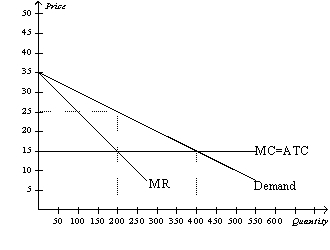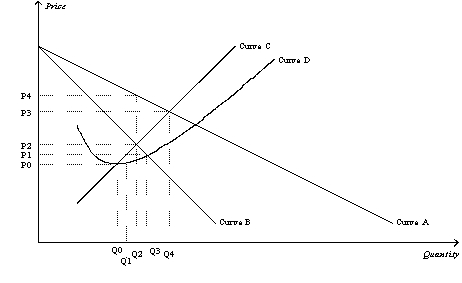A) increases profits to the firm.
B) increases total surplus.
C) decreases consumer surplus.
D) All of the above are correct.
Correct Answer

verified
Correct Answer
verified
Multiple Choice
Figure 14-15  -Refer to Figure 14-15.If the monopoly firm perfectly price discriminates,then consumer surplus amounts to
-Refer to Figure 14-15.If the monopoly firm perfectly price discriminates,then consumer surplus amounts to
A) $0.
B) $250.
C) $500.
D) $1,000.
Correct Answer

verified
Correct Answer
verified
Multiple Choice
Table 14-6
A monopolist faces the following demand curve:
 -Refer to Table 14-6.Suppose the monopolist has total fixed costs equal to $5 and a variable cost equal to $4 per unit for all units produced.What is the total profit if she operates at her profit-maximizing price?
-Refer to Table 14-6.Suppose the monopolist has total fixed costs equal to $5 and a variable cost equal to $4 per unit for all units produced.What is the total profit if she operates at her profit-maximizing price?
A) $1
B) $7
C) $9
D) $11
Correct Answer

verified
Correct Answer
verified
True/False
By offering lower prices to customers who buy a large quantity,a monopoly is price discriminating.
Correct Answer

verified
Correct Answer
verified
True/False
During the life of a drug patent,the monopoly pharmaceutical firm maximizes profit by producing the quantity at which marginal revenue equals marginal cost.
Correct Answer

verified
Correct Answer
verified
Multiple Choice
If a monopoly lowers its price,its
A) total revenue must increase.
B) total revenue must decrease.
C) marginal revenue must increase.
D) marginal revenue must decrease.
Correct Answer

verified
D
Correct Answer
verified
True/False
By selling hardcover books to die-hard fans and paperback books to less enthusiastic readers,the publisher is able to price discriminate and raise its profits.
Correct Answer

verified
Correct Answer
verified
Multiple Choice
Which of the following statements is correct?
A) The demand curve facing a competitive firm is horizontal,as is the demand curve facing a monopolist.
B) The demand curve facing a competitive firm is downward sloping,whereas the demand curve facing a monopolist is horizontal.
C) The demand curve facing a competitive firm is horizontal,whereas the demand curve facing a monopolist is downward sloping.
D) The demand curve facing a competitive firm is downward sloping,as is the demand curve facing a monopolist.
Correct Answer

verified
C
Correct Answer
verified
Multiple Choice
Which of the following is an example of a barrier to entry?
A) Tom charges a higher price than his competitors for his house-painting services.
B) Dick obtains a copyright for the new computer game that he invented.
C) Harry offers free concerts on Sunday afternoons as a form of advertising.
D) Larry charges a lower price than his competitors for his lawn-mowing services.
Correct Answer

verified
Correct Answer
verified
Multiple Choice
Name brand drugs are able to continue capitalizing on their market power even after generic drugs enter the market because (i) almost all people fear the generic drug companies are devoting too few resources to research and development. (ii) some people fear that generic drugs are inferior. (iii) some people are loyal to the name brand.
A) (i) and (ii) only
B) (ii) and (iii) only
C) (i) and (iii) only
D) (i) ,(ii) ,and (iii)
Correct Answer

verified
Correct Answer
verified
Multiple Choice
The deadweight loss associated with a monopoly occurs because the monopolist
A) maximizes profits.
B) produces an output level less than the socially optimal level.
C) produces an output level greater than the socially optimal level.
D) equates marginal revenue with marginal cost.
Correct Answer

verified
Correct Answer
verified
Multiple Choice
When a firm experiences continually declining average total costs,
A) the firm is a price taker.
B) society is better served by having one firm supply the product.
C) the firm will earn higher profits than if average total costs are increasing.
D) All of the above are correct.
Correct Answer

verified
Correct Answer
verified
Multiple Choice
Table 14-9
Consider the following demand and cost information for a monopoly.
 -Refer to Table 14-9.What is the marginal revenue of the 3rd unit?
-Refer to Table 14-9.What is the marginal revenue of the 3rd unit?
A) $4
B) $12
C) $20
D) $28
Correct Answer

verified
Correct Answer
verified
Multiple Choice
If a monopolist can practice perfect price discrimination,the monopolist will
A) eliminate consumer surplus.
B) eliminate deadweight loss.
C) maximize profits.
D) All of the above are correct.
Correct Answer

verified
Correct Answer
verified
Multiple Choice
How does a competitive market compare to a monopoly that engages in perfect price discrimination?
A) In both cases,total social welfare is the same.
B) Total social welfare is higher in the competitive market than with the perfectly price discriminating monopoly.
C) In both cases,some potentially mutually beneficial trades do not occur.
D) Consumer surplus is the same in both cases.
Correct Answer

verified
Correct Answer
verified
Multiple Choice
A monopolist faces the following demand curve:  The monopolist has fixed costs of $1,000 and has a constant marginal cost of $2 per unit.If the monopolist were able to perfectly price discriminate,how many units would it sell?
The monopolist has fixed costs of $1,000 and has a constant marginal cost of $2 per unit.If the monopolist were able to perfectly price discriminate,how many units would it sell?
A) 400
B) 500
C) 900
D) 4,200
Correct Answer

verified
Correct Answer
verified
Multiple Choice
When a certain monopoly sets its price at $8 it sells 64 units.When the monopoly sets its price at $10 it sells 60 units.The marginal revenue for the firm over this range is
A) $11.
B) $22.
C) $33.
D) $44.
Correct Answer

verified
Correct Answer
verified
Multiple Choice
A monopoly
A) can set the price it charges for its output and earn unlimited profits.
B) takes the market price as given and earns small but positive profits.
C) can set the price it charges for its output but faces a downward-sloping demand curve so it cannot earn unlimited profits.
D) can set the price it charges for its output but faces a horizontal demand curve so it can earn unlimited profits.
Correct Answer

verified
Correct Answer
verified
Multiple Choice
Figure 14-3  -Refer to Figure 14-3.If the monopoly firm wants to maximize its profit,it should operate at a level of output equal to
-Refer to Figure 14-3.If the monopoly firm wants to maximize its profit,it should operate at a level of output equal to
A) Q1.
B) Q2.
C) Q3.
D) Q4.
Correct Answer

verified
B
Correct Answer
verified
Multiple Choice
Price discrimination explains why Ivy League universities often base tuition costs on students'
A) age.
B) financial resources.
C) high school GPA.
D) gender.
Correct Answer

verified
Correct Answer
verified
Showing 1 - 20 of 526
Related Exams